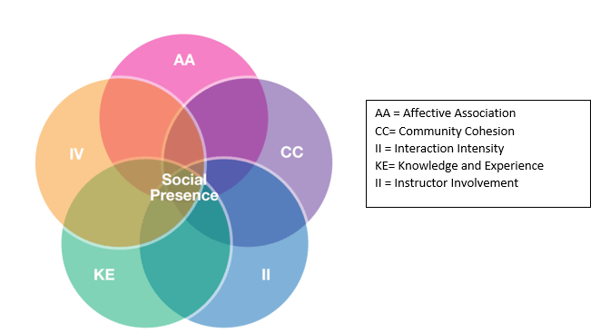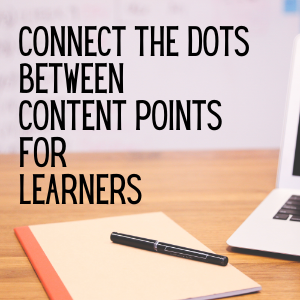
 In the recent rush to move so much training from face-to-face to the virtual setting, there’s a great deal of conversation about the technology: which platform, dealing with security settings, how to create backgrounds. There’s less conversation, though, about the role of the facilitator and the skills needed to bring the energy and feeling of connectedness of the live event to the live online one.
In the recent rush to move so much training from face-to-face to the virtual setting, there’s a great deal of conversation about the technology: which platform, dealing with security settings, how to create backgrounds. There’s less conversation, though, about the role of the facilitator and the skills needed to bring the energy and feeling of connectedness of the live event to the live online one.
Social presence refers to the collection of behaviors that help participants in a virtual environment see the facilitator -- and each other -- as human. Is this a ‘real’ person? Do I feel that they are really there, now?
It begins with introductions, real-time activities, participation in text chat conversations, use of names, and having some awareness of who people are as humans and referring to them in context (“Sarah, you work in procurement, what do you know about ____?”; “Bill, I know you’re juggling work with homeschooling your daughter. How are you ______?” ). An excellent article from Dikkers, Whiteside, & Lewis (Learning & Leading with Technology, v40 n2 p22-25 Sep-Oct 2012) provides a model of social presence as a framework for developing a more meaningful, enriching online experience.
 Social Presence Model from Dikkers, A.; Whiteside, A., & Lewis, S. 2012.
Social Presence Model from Dikkers, A.; Whiteside, A., & Lewis, S. 2012.
1. Affective association addresses the emotional connections in an experience. It includes emotion, humor, sarcasm, the speed, pitch, and tone of voice, and self-disclosure.
- Let them see you. If using a video platform, great. If not, make an introductory video, or include voice over commentary on materials. Invite verbal participation and unmute mics now and again so people can hear each other’s voices.
- Make strategic use of announcements, personalized emails, and personalized feedback. If a class involves testing or graded assignments, make sure people know you’re not just a bot scoring a quiz. Take time to message someone who’s been unusually quiet, or whose question you didn’t get to during the live session. Offer office hours.
- Written communications can start before the experience proper. Is the class notice just a form letter with a link and password? A formal letter describing the course and expectations? Is the tone friendly and warm or businesslike and stiff? Does it list professional credentials? Do you mention your pet ferret or your love of music? Do you discuss your own interest in or background with the topic? Everything you do here is a choice, and it’s one that will affect the rest of the experience.
2. Community cohesion refers to the extent in which participants see the group as a community and not just a collection of isolated learners. This is expressed by greetings and salutations, referring to each other as a community, and referencing each other by name. Do they use words like “us”, “we”, and “our”? Work to encourage an atmosphere of collective learning –and try to be part of that.
3. Interaction intensity: This examines the amount and quality of interaction among participants. Do you see things like direct quotes, paraphrasing, complimenting, and asking questions among the learners? Provide opportunities for collaborative activities and offer interesting, engaging content that invites meaningful interaction. Ask interesting questions that prompt reflection or deeper thinking.
4. Knowledge and experience: Invite participants to share additional resources and experiences. Ask them to tap prior knowledge, tell a story, or connect content to their own lives/make content personally relevant. Solicit their solutions, ideas, war stories, and success stories. An advantage of working with adult learners is they have past experiences, so take the opportunity to invite their input.
5. Instructor involvement is the extent to which the instructor is an invested, active partner in the learning community. Try to minimize automated messages; when possible, send personalized notes. Pick up the phone or set up a one-on-one video chat. Make specific comments about their work. Use their names. Respond. Participate in session text chat and discussions elsewhere, such as on class discussion boards or social channels. Ultimately: Do the participants see you as an involved participant in their learning community?
In considering presence, think about intimacy and immediacy: Is there room for the humans in the experience to emerge? And is there a feeling that the experience is happening in the moment?
Finally, the facilitator needs to bring attitudinal vitality to the experience. Regardless of personality, the facilitator should strive to convey a sense of presence, enthusiasm for the topic and the trainer role, and a sincere desire to help learners learn. You don’t have to be exuberant or sunny if that’s just not you, but a grumpy or disinterested facilitator will be hard-pressed to provide a good experience. You can’t not set a tone: Which tone will yours be?
Summary: It’s not just about you delivering, and participants receiving, content. In a traditional face-to-face class, a facilitator does not just appear, say hello, and start reading slides. There is a bit of chitchat, maybe some introductions or sharing goals for the event. During class and breaks people pick up on characteristics of different personalities in the group. Even a stiff, formal presenter and quiet participants in the back of the room are seen as human. Look for ways to bring the best of that live face-to-face setting to your online work. With attention and some effort, you will likely provide your learners with equivalent – or better- experiences.

How to Go Live: Thinking About Virtual Classroom Facilitation
We all know that organizations have had to quickly move face-to-face training to the virtual classroom. This seismic shift extends beyond...

